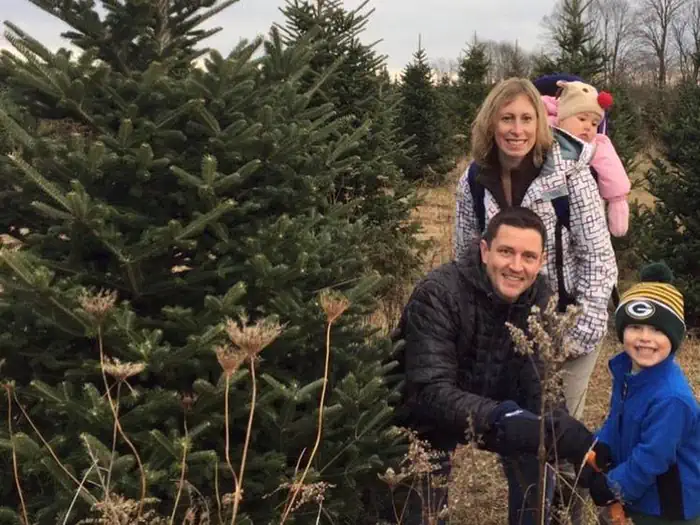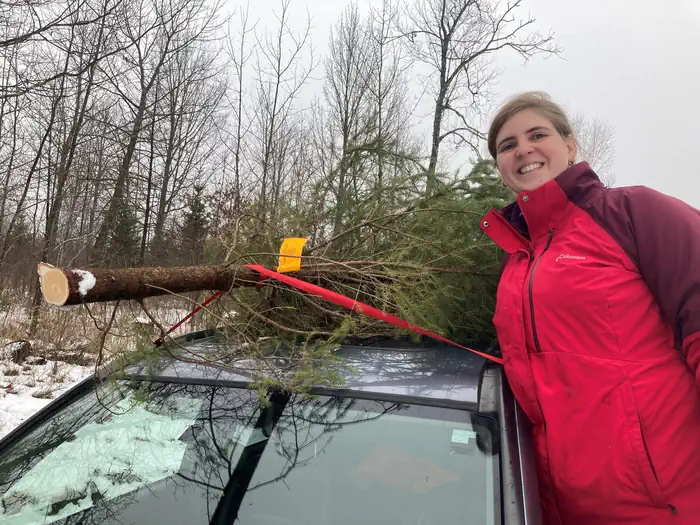Chequamegon-Nicolet National Forest Christmas Tree Permit
This permit allows you to cut a Christmas Tree within designated areas of the Chequamegon-Nicolet National Forest! Lifelong memories are built during these special times and we are happy to help with any information gathering you'll need to make this trip a safe and enjoyable one.
Many people enjoy the experience of hiking in the woods to find the perfect Christmas tree. While the trees in the forest are not professionally trimmed or groomed, many enjoy them for their natural appearance. The most popular tree species is balsam fir, which is plentiful and retains needles very well. Balsam firs are not as abundant on the Washburn District, and, as a result, red and scotch pines are preferred.
Please be sure to read and agree to all the tips and guidelines when selecting your tree.
Individuals may purchase up to five permits. Each permit covers the harvest of one tree.
Need to Know
Selecting Your Tree
Each forest has limitations on the size of the tree you can cut and the species of trees that are permitted. See below to help you measure and choose a tree that meets your permit's guidelines.
Tree Height: 20 feet maximum
Stump height: 6 inches maximum (Trees must be cut as close to the ground as possible)
Take the whole tree. Do not remove the top of the tree; cut down the entire tree. Any debris or branches from the cutting should be removed from the cleared portion of roads and trails.
If snow is on the ground, remove it from around the stump so you can accurately measure the stump and tree height.
Where to Cut Your Tree
Know where you are and do not cut on private land.
Permit Area Description: All National Forest land except for: Wilderness Areas, Research Natural Areas, Developed Recreation Areas, Administrative Areas, the Argonne Experimental Forest, or within 100 feet of a lake or pond.
Gathering is not allowed within 100 feet of hiking trails that are within one half mile of developed camp grounds.
Trees may be cut along roads and trails, although harvesters are asked to consider aesthetics and safety.
Do not cut Northern White Cedar or Hemlocks.
Balsam firs are not as abundant on the Washburn District, and, as a result, red and scotch pines are preferred.
Trees cut under this permit are for personal use and are not to be sold for commercial purposes.
This permit is valid for harvest of one tree.
Planning Your Trip
Helpful Cutting Tips
Carry your tree carefully out of the woods. Dragging the tree will rub off needles and bark.
If the tree is too big to transport inside of your vehicle, wrap it in canvas to prevent wind damage.
Once home, cut the bottom of the trunk off and place the freshly cut trunk in a bucket of water. Replenish water.
If storing your tree outside for a few days before putting it in the house, keep it in an area protected from the wind, such as the north or east side of your house or under a shaded tree.
Tools you might want to consider bringing with you include a measuring tape to ensure you select a tree that fits in your home; handsaw to cut your tree; gloves to protect your hands; boots to protect your feet; a tarp to sit on and/or to move your tree once it's cut; and rope or straps to secure your tree to your vehicle.
Choose a tree from a dense forested area, which will give the remaining trees more space to grow.
Cut the leftover branches from the stump and scatter them so as not to leave any debris on portions of roads and trails.
How to Plan Your Trip
Before you leave home, be sure to measure the space where you plan to place the tree in your home (height and width), and measure the space in your vehicle where you will be transporting the tree.
You must print and bring your Christmas Tree Permit with you.
Cell service may be spotty or unavailable. Be sure someone knows where you are and when to expect you back.
Check the latest weather conditions, forest warnings and road closures before you leave on your trip. Dress warm and take extra dry clothes. Expect winter weather, including cold temperatures, snow and winds.
Bring a map with you. Don’t rely on GPS because it may not be up-to-date with forest service roads.
Some roads may not be plowed. Be sure your vehicle has a full tank of gas. Bring a spare key and give it to someone else in your party. Don’t get locked out of your car! Park in areas so that traffic can get by safely, and do not block gates.
Bring plenty of food and water with you as well as an overnight survival kit in case you become stranded. Start your day early. Be sure to find your tree and leave the woods before dark.
We don't recommend bringing your pets but, if you do, we recommend they be on a leash.



